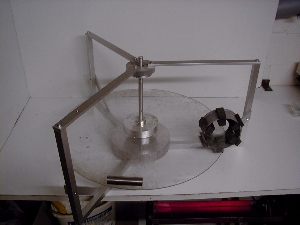 |
 |
last update 09/17/99
topics: magnetic hole, no overunity |
| project: started: finished: description: |
RoMagHole 05 / 1999 07 / 1999 as i saw jean louis naudin's experiments on his webpage, i was fascinated and wanted to proof the 1:2.5 ratio of his magnetic hole tests. i made plans for a rotating version of his experiment and began to build the support for a plexi-glass-disc which rotates and is held by an axle with two bearings (upper and lower). the plexi-glass-disc is mounted horizontally and can freely rotate. an alnico magnet was fixed with tape at the outer part of the disc. this magnet rotates through a magnetic hole which is made with a plastic pipe-end. some ferrite block magnets are fixed at this pipe-end with north pole facing inwards generating a north monopole at the inner part (magnetic hole). |
| results: | when i rotate the disc with my hands there can be
seen an oszillating rotation (speed decreases at entry and increases when exiting the
magnetic hole - or vice versa). the losses of the device are very small, but the rotation
stops after several (ca. 50) rotations undependent of the rotation direction. the force
diffence at entering/exiting has been measured with a torque arm and a digital balance. i
can confirm the ratio of 1:2.5 that jean
louis naudin measured at his device. the problem why the ratio could not be used for
overunity is, that the way, the alnico magnet must go through the weak magnetic field on
entry (repulsion) is 2.5 times longer than the way it is repelled at the stronger but
shorter magnetic repulsion when exiting the magnetic hole. (the way is not really 2.5 times longer, because the force increases exponentially - to imagine a constant force is easier) power is distance x force. the power needed on entry cancels the power "generated" when exiting the hole. |
| remarks: | i also tried several magnets at different positions and several counts. multiple magnetic holes were tried also as different magnetic hole strengths |
| comments: | From Shane
Kroll: shane@jetlink.net It's just a thought, but why couldn't a person use 4 rod magnets and 4 rings/gates. Adjust the time of entry in each successive gate so that the exit force of each retreating gate is used to move the rod magnets into the following gate. Kind of a 1, 2, 3 .... push. Instead of the walls (of the gate's) being paralell to the rod magnets, how about angling them slightly. If the diameter of the gates were smaller at the entry point and larger at the exit point, would the lateral repulsion of the angled magnets add to the exit force ? |
| pictures: |  overview of the device click image for fullsize (1280 x 1024, 160kb)
if you have any suggestions, comments or enhancement ideas to this device, please mail to bitbo@t-online.de this device is for sale. my building costs are about $100 and i will sell it for $40 + shipping is you are interested.
|
energy conversion systems - copyright '99 by bitbo@t-online.de |